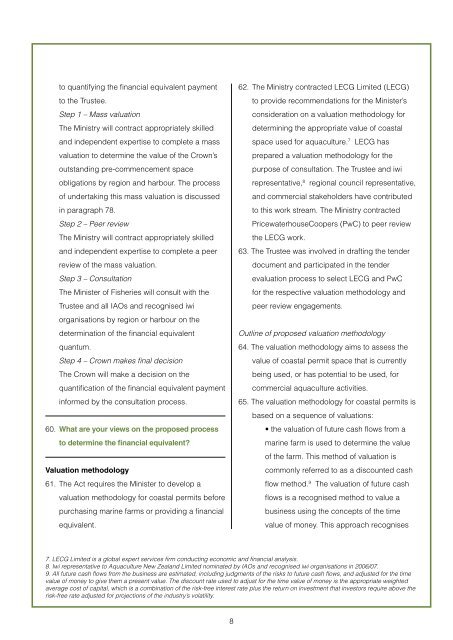maori commercial aquaculture settlement - Ministry of Fisheries
maori commercial aquaculture settlement - Ministry of Fisheries
maori commercial aquaculture settlement - Ministry of Fisheries
Create successful ePaper yourself
Turn your PDF publications into a flip-book with our unique Google optimized e-Paper software.
to quantifying the financial equivalent payment<br />
to the Trustee.<br />
Step 1 – Mass valuation<br />
The <strong>Ministry</strong> will contract appropriately skilled<br />
and independent expertise to complete a mass<br />
valuation to determine the value <strong>of</strong> the Crown’s<br />
outstanding pre-commencement space<br />
obligations by region and harbour. The process<br />
<strong>of</strong> undertaking this mass valuation is discussed<br />
in paragraph 78.<br />
Step 2 – Peer review<br />
The <strong>Ministry</strong> will contract appropriately skilled<br />
and independent expertise to complete a peer<br />
review <strong>of</strong> the mass valuation.<br />
Step 3 – Consultation<br />
The Minister <strong>of</strong> <strong>Fisheries</strong> will consult with the<br />
Trustee and all IAOs and recognised iwi<br />
organisations by region or harbour on the<br />
determination <strong>of</strong> the financial equivalent<br />
quantum.<br />
Step 4 – Crown makes final decision<br />
The Crown will make a decision on the<br />
quantification <strong>of</strong> the financial equivalent payment<br />
informed by the consultation process.<br />
60. What are your views on the proposed process<br />
to determine the financial equivalent?<br />
Valuation methodology<br />
61. The Act requires the Minister to develop a<br />
valuation methodology for coastal permits before<br />
purchasing marine farms or providing a financial<br />
equivalent.<br />
8<br />
62. The <strong>Ministry</strong> contracted LECG Limited (LECG)<br />
to provide recommendations for the Minister’s<br />
consideration on a valuation methodology for<br />
determining the appropriate value <strong>of</strong> coastal<br />
space used for <strong>aquaculture</strong>. 7 LECG has<br />
prepared a valuation methodology for the<br />
purpose <strong>of</strong> consultation. The Trustee and iwi<br />
representative, 8 regional council representative,<br />
and <strong>commercial</strong> stakeholders have contributed<br />
to this work stream. The <strong>Ministry</strong> contracted<br />
PricewaterhouseCoopers (PwC) to peer review<br />
the LECG work.<br />
63. The Trustee was involved in drafting the tender<br />
document and participated in the tender<br />
evaluation process to select LECG and PwC<br />
for the respective valuation methodology and<br />
peer review engagements.<br />
Outline <strong>of</strong> proposed valuation methodology<br />
64. The valuation methodology aims to assess the<br />
value <strong>of</strong> coastal permit space that is currently<br />
being used, or has potential to be used, for<br />
<strong>commercial</strong> <strong>aquaculture</strong> activities.<br />
65. The valuation methodology for coastal permits is<br />
based on a sequence <strong>of</strong> valuations:<br />
• the valuation <strong>of</strong> future cash flows from a<br />
marine farm is used to determine the value<br />
<strong>of</strong> the farm. This method <strong>of</strong> valuation is<br />
commonly referred to as a discounted cash<br />
flow method. 9 The valuation <strong>of</strong> future cash<br />
flows is a recognised method to value a<br />
business using the concepts <strong>of</strong> the time<br />
value <strong>of</strong> money. This approach recognises<br />
7. LECG Limited is a global expert services firm conducting economic and financial analysis.<br />
8. Iwi representative to Aquaculture New Zealand Limited nominated by IAOs and recognised iwi organisations in 2006/07.<br />
9. All future cash flows from the business are estimated, including judgments <strong>of</strong> the risks to future cash flows, and adjusted for the time<br />
value <strong>of</strong> money to give them a present value. The discount rate used to adjust for the time value <strong>of</strong> money is the appropriate weighted<br />
average cost <strong>of</strong> capital, which is a combination <strong>of</strong> the risk-free interest rate plus the return on investment that investors require above the<br />
risk-free rate adjusted for projections <strong>of</strong> the industry’s volatility.
















